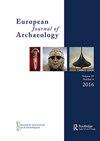‘Unmaking’ the Deer in Medieval Europe: Historical and Archaeological Evidence
IF 1.2
2区 历史学
0 ARCHAEOLOGY
引用次数: 0
Abstract
Deer hunting was heavily ritualized in medieval Europe, as indicated by historical and archaeological evidence; it also emphasized social differentiation. The butchery of a deer carcass (‘unmaking’) was integral to the ritual and led to different body parts being destined for individuals of differing status. Archaeologically, the practice is particularly visible in high-status sites in Britain, but documentary and archaeological sources are consistent in pinpointing its earliest occurrence in twelfth-century France. In Italy, late medieval evidence for such ‘unmaking’ is present but is not supported by any known historical sources. Red and fallow deer were butchered in a formalized manner, whereas the data for roe deer are unclear. Although the Normans contributed to the diffusion of the ‘unmaking’ practice, in France it is also found outside the core area of Norman influence. The extensive spread of the practice demonstrates the connectedness of the medieval hunting culture in Europe.中世纪欧洲的 "解鹿":历史和考古证据
历史和考古证据表明,在中世纪的欧洲,狩鹿仪式化程度很高;狩鹿还强调社会分化。屠宰鹿尸("解鹿")是狩猎仪式不可或缺的一部分,这导致鹿的不同部位被分配给不同地位的人。从考古学角度看,这种习俗在英国地位较高的遗址中尤为明显,但文献和考古资料一致认为,这种习俗最早出现在 12 世纪的法国。在意大利,中世纪晚期有证据表明存在这种 "解制 "做法,但没有任何已知的历史资料支持。红鹿和秋鹿的屠宰是正规的,而狍子的屠宰数据则不清楚。虽然诺曼人促进了 "解制 "习俗的传播,但在法国,这种习俗也出现在诺曼人影响的核心区域之外。这种习俗的广泛传播表明了欧洲中世纪狩猎文化的关联性。
本文章由计算机程序翻译,如有差异,请以英文原文为准。
求助全文
约1分钟内获得全文
求助全文
来源期刊

European Journal of Archaeology
ARCHAEOLOGY-
CiteScore
3.40
自引率
6.70%
发文量
58
期刊介绍:
The publication organ of the European Association of Archaeologists, the European Journal of Archaeology seeks to promote open debate amongst archaeologists committed to a new idea of Europe in which there is more communication across national frontiers and more interest in interpretation. The journal accepts not only new empirical data and new interpretations of the past but also encourages debate about the role archaeology plays in society, how it should be organized in a changing Europe, and the ethics of archaeological practice. All periods are covered; papers, review articles, interviews and short "debate" pieces are all sought. Whilst English is the primary language of publication in the EJA, papers submitted in French or German will be given equal consideration.
 求助内容:
求助内容: 应助结果提醒方式:
应助结果提醒方式:


